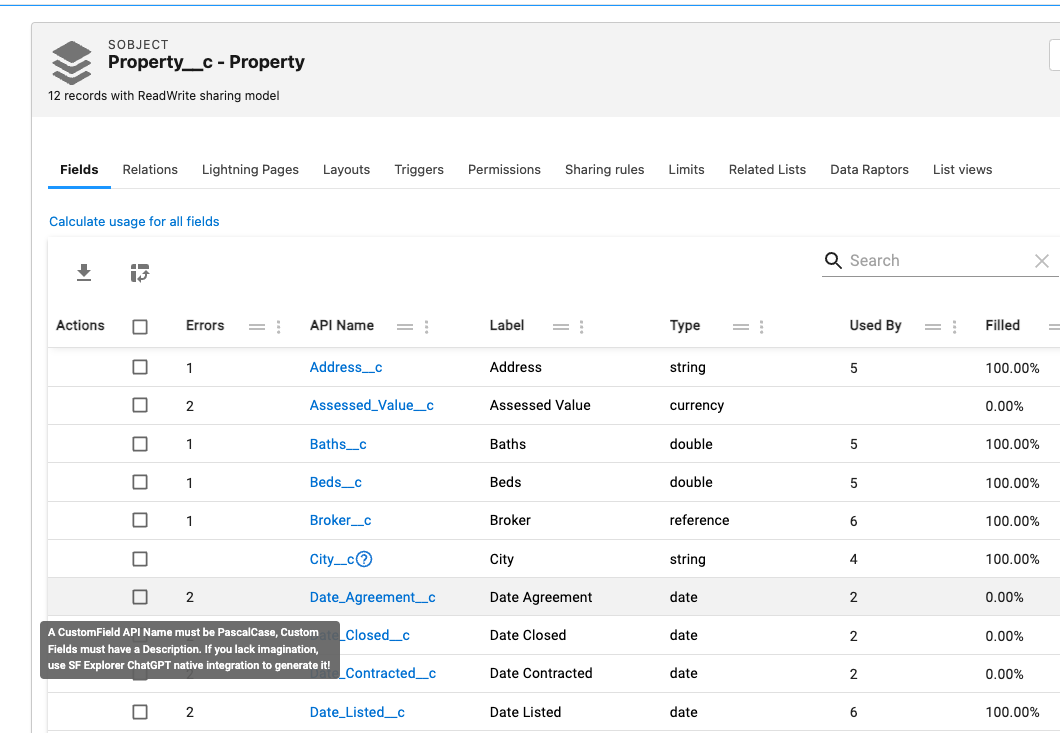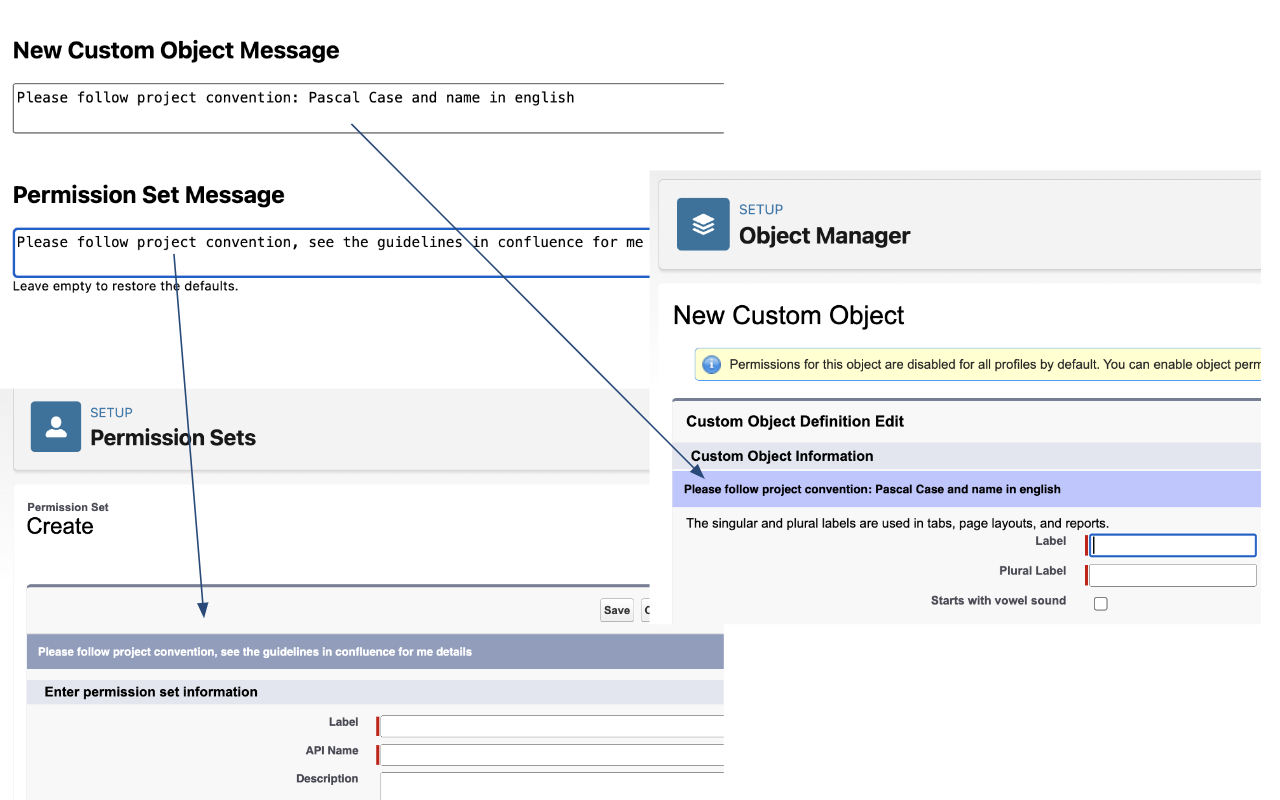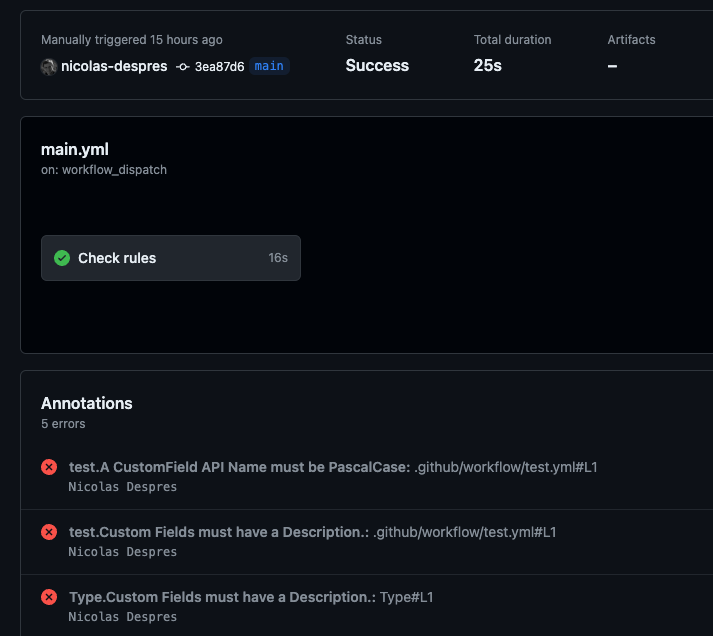Introduction
Let's bridge the gap between best practice theory and how we enforce it!
SF Explorer allows you to define and perform simple checks on your orgs Data and Metadata in a simple yet flexible manner.
You can access, run and configure those rules via Devops > Best Practices

You can run the report at a given date. Above 01/01/2024
UI integration
Once defined, errors will be showned contextually on your records as you navigate through SF Explorer:

Setup Enhancement
Enhance your Salesforce setup with checks and best practices with a new chrome extension called SF Explorer Advanced Setup
It adds custom message into your Salesforce setup screen to enforce your project rules are enforced. Your Design Authority should be pleased! You can add a custom messages for:
-
New Custom Object
-
New Permission Set Those messages are configurable in the option page.
-
It prevent user from creating duplicate fields
-
It shows similar fields when opening a custom field

Command line integration
It is simple to integrate those rules in your current pipelines, for example with a Github Action:

Create a file named .env with the following content:
SFEXP_LOGIN=XXX # remove it to use SFDX instead
SFEXP_PASSWORD=XXX # Password+SecurityToken, remove it to use SFDX instead
LOGINURL=https://login.salesforce.com #or https://test.salesforce.com
DATE=TODAY #or 2024-01-01
RULES=EntityDefinition,CustomField #specify to only run rules on EntityDefinition and CustomField - remove param to check all rules
To connect with SFDX, don't use the SFEXP_LOGIN/SFEXP_PASSWORD env var.
Run the command:
npx @sf-explorer/devops.cli
The command will generate an output file name testReport.xml (in JUnit format).
Ignore metadata
You can ignore specific errors with a file named .sfexplorerignore (using regex similar to a .gitignore file)
- ignore an author with @ and the author name
- ignore a record with its type and target
Sample Rules on Basic Entities
EntityDefinition
A custom object Name must be in english and PascalCase
A custom object Description is required
Less than 100 custom fields
Maximum one custom trigger per object
Maximum 15 record types per object
CustomField
A CustomField API Name must be in english and PascalCase
Custom Fields must have a Description (at least 20 chars)
Flow
Flow Description is required (at least 20 chars)
Flow Label must be Short Yet Meaningful
PermissionSet
Name is following project convention
Description is required (more than 20 chars)
ApexClass
An Apex class name must be PascalCase and use a correct Suffix
An ApexClass must follow the best practices
An ApexClass must have a Description
An ApexClass must have an author
Apex variables must be camelCase
Apex methods must be camelCase
LightningComponentResource
An LWC must have an author
An LWC must have a description
FieldPermissions
No field level security on Profiles (except System Administrator)
Sample Rules on Omnistudio
OmniUiCard
Flexcards names must be pascal case
Flexcards must have a description
OmniProcess
Omniscript Type should be camel case (for LWC compatibility)
Omniscript SubType must be PascalCase
Omniscripts must have a description
Omniscript must have less than 100 elements
OmniProcessElement
Remote action and DataRaptor Actions must have a description
Set Values and Set Errors must start with Set+PascalCase
Remote Action must start with 'Invoke+PascalCase'
DataRaptor Extract must start with 'DRE+PascalCase'
DataRaptor Post must start with 'DRP+PascalCase'
DataRaptor Extract must start with 'IP+PascalCase'